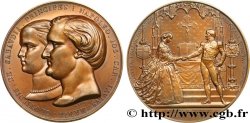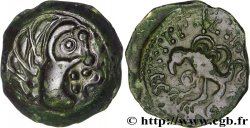fme_928660 - SECOND EMPIRE Médaille, Palais de l’Industrie, Vue des galeries
200.00 €
Количество
Добавить в корзину

Тип Médaille, Palais de l’Industrie, Vue des galeries
Дата: 1855
Монетный двор / Город: 75 - Paris
Металл: copper
Диаметр: 67,5 mm
Ориентация осей монеты: 12 h.
Гравер CAQUÉ Armand Auguste (1795-1881) / GERVAIS ET CIE EDIT.
Вес: 166,61 g.
Век: lisse + Main CUIVRE
Пуансон: main indicatrice (1845-1860) et CUIVRE
Комментарии о состоянии
Jolie patine marron présentant quelques traces de manipulation
Лицевая сторона
Аверс: легенда: EUGÉNIE IMPÉRATRICE . NAPOLÉON III EMPEREUR.
Аверс: описание: Têtes d’Eugénie et de Napoléon III à gauche, signé : CAQUE. F. / GRAVEUR DE S. M. L’EMPEREUR.
Обратная сторона
Реверс: легенда: PALAIS DE L’INDUSTRIE / VUE DES GALERIES.
Реверс: Описание: Vue de l’intérieur du palais de l’Industrie, avec les galeries et colonnades. Signé : JACQUES WIENER FEC. et MANGUIN DEL..
Комментарий
Médaille conservée dans un écrin rouge à la fermeture en partie cassée.
Diverses médailles commémorent l’édification de ce Palais de l’Industrie.
Le Palais de l'Industrie et des Beaux-arts, ou plus communément Palais de l'Industrie, est un édifice construit pour l'Exposition universelle de 1855 sur les Champs-Élysées à Paris. Il est l'œuvre de l'architecte Victor Viel et de l'ingénieur Alexis Barrault. Il est détruit à partir de 1896 pour laisser place au Petit Palais et au Grand Palais.
Inauguré le 15 mai 1855 par Louis-Napoléon Bonaparte, récemment devenu l'empereur Napoléon III, il fut l'emblème de la première Exposition universelle française. Cette Exposition, qui attira plus de cinq millions de visiteurs, fut la réponse du chef de l'État français au succès de l'Exposition universelle de 1851 de Londres, célébrée notamment pour l'audace et la nouveauté de son Crystal Palace.
Diverses médailles commémorent l’édification de ce Palais de l’Industrie.
Le Palais de l'Industrie et des Beaux-arts, ou plus communément Palais de l'Industrie, est un édifice construit pour l'Exposition universelle de 1855 sur les Champs-Élysées à Paris. Il est l'œuvre de l'architecte Victor Viel et de l'ingénieur Alexis Barrault. Il est détruit à partir de 1896 pour laisser place au Petit Palais et au Grand Palais.
Inauguré le 15 mai 1855 par Louis-Napoléon Bonaparte, récemment devenu l'empereur Napoléon III, il fut l'emblème de la première Exposition universelle française. Cette Exposition, qui attira plus de cinq millions de visiteurs, fut la réponse du chef de l'État français au succès de l'Exposition universelle de 1851 de Londres, célébrée notamment pour l'audace et la nouveauté de son Crystal Palace.








 Cообщить об ошибке
Cообщить об ошибке Распечатать страницу
Распечатать страницу Отправить мой выбор
Отправить мой выбор Задать вопрос
Задать вопрос Consign / sell
Consign / sell
 Информация
Информация











